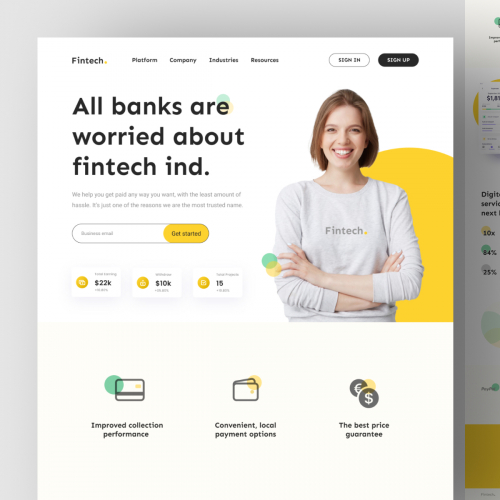Easy-to-Navigate Website Design Services That Improve Navigation and User Experience
Easy-to-Navigate Website Design Services That Improve Navigation and User Experience
Blog Article
Top Tips for Creating an Impactful Web Site Design That Transforms
To accomplish this, one must think about a range of aspects, consisting of understanding the target audience, focusing on individual experience, and optimizing for mobile platforms. The tactical use of engaging call-to-actions and a well-defined visual hierarchy plays an essential duty in assisting users via their journey.
%20%5B60%25%5D.jpg)
Understand Your Target Market
Recognizing your target audience is basic to effective web site layout, as it prepares for producing an interesting user experience. Recognizing who your customers are, including their demographics, preferences, and behaviors, allows designers to customize the site's material, format, and performance to fulfill certain requirements.
Conducting thorough marketing research is crucial in this process. Studies, interviews, and analytics can give important insights right into customer expectations and pain factors. By compiling this data, developers can create individual characters that stand for different sectors of the target market, ensuring that layout choices are educated and pertinent.
In addition, understanding the target market aids in picking suitable design components such as shade schemes, typography, and images that resonate with users. A site that talks straight to its audience fosters a sense of connection and trust, urging longer check outs and greater conversion prices.
Inevitably, a user-centered technique to web site layout not only enhances individual contentment yet also supports company objectives by driving involvement and commitment. By focusing on the needs and choices of the target market, a website can efficiently offer its purpose and attain desired outcomes.
Prioritize User Experience
To enhance the general performance of an internet site, focusing on user experience (UX) is important (Website Design). A well-designed UX makes sure that visitors can browse the website easily, locate details rapidly, and engage with content meaningfully. This leads to increased customer complete satisfaction and higher conversion prices
Begin by applying user-friendly navigating. Menus ought to be rationally structured, allowing users to find essential areas of the website with minimal effort. Uniformity in style elements, such as color design and font styles, promotes familiarity, which is crucial for keeping user engagement.
Additionally, take into consideration the packing rate of your internet site. A delay of simply a couple of seconds can bring about substantial drop-offs, as customers are much less most likely to await a slow-loading page. Improving photos and maximizing code can enhance performance and keep visitors.
In addition, clarity in material presentation is essential. Use succinct, interesting language and separate text with visuals to enhance readability. By focusing on customer experience, you not only create a much more satisfying environment for site visitors but likewise enhance your brand name's reliability. Eventually, an click for source emphasis on UX is a financial investment in the long-term success of your website.
Maximize for Mobile Devices
Enhancing for mobile phones is crucial in today's digital landscape, where an enhancing number of individuals accessibility websites through smartphones and tablets. A mobile-friendly layout not just improves customer experience but likewise plays a substantial function in boosting internet search engine rankings. To accomplish this, it is necessary to adopt a responsive style that immediately gets used to numerous screen dimensions and positionings.

Packing speed is an additional essential element; mobile users are generally less individual and expect rapid access to information. By focusing on mobile optimization, you ensure that your internet site continues to be affordable and properly engages a more comprehensive audience.
Usage Compelling Call-to-Actions
A site's performance typically hinges on its capacity to lead visitors toward wanted actions, making engaging call-to-actions (CTAs) necessary components of design. CTAs serve as the critical points that route individuals to engage with the website, whether that implies purchasing, signing up for a newsletter, or downloading and install a source.
To produce reliable CTAs, clearness is critical. Use succinct language that clearly connects the activity you desire the customer to take. Phrases such as "Start," "Join Free," or "Shop Now" not only share necessity yet also eliminate uncertainty. The placement of CTAs is just as crucial; they should be strategically positioned throughout the web page to guarantee they are quickly noticeable, specifically in high-traffic areas.
In addition, the design of CTAs must stick out without being obtrusive. Use contrasting shades and clear font styles to ensure they record interest. Furthermore, consider utilizing directional signs, such as arrowheads or images, to lead individuals towards these buttons. By concentrating on these elements, businesses can dramatically enhance user engagement, driving conversions and eventually achieving their site's objectives.
Focus on Visual Pecking Order
Reliable internet site style relies greatly on a well-structured aesthetic hierarchy that overviews users via material flawlessly. By organizing components in a manner that focuses on details, designers can improve user experience and help with decision-making. This involves utilizing size, shade, comparison, and spacing purposefully to attract interest to the most critical elements of a website.
Making use of bigger typefaces for headings and subheadings establishes a clear distinction in between various sections, enabling individuals to check content effortlessly. Additionally, utilizing different colors for switches and calls-to-action can record individual interest and encourage interaction. Whitespace is an you could try these out additional necessary element; it prevents clutter and allows customers to concentrate on key messages without disturbances.
Photos and graphics ought to match the text while additionally adhering to the established power structure, enhancing the general message (Website Design). Uniformity in design aspects, such as color pattern and typography, further enhances the visual power structure, making navigating intuitive

Conclusion
In conclusion, effective web site layout necessitates a comprehensive understanding of the target audience, prioritization of customer experience, and mobile optimization. Ultimately, a well-executed web site style serves as a critical component in driving user actions and attaining service objectives.
Report this page